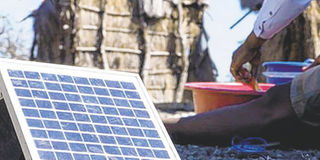E-learning and the tale of blackouts

Blackouts affect e-learning in Africa. PHOTOI BBC
What you need to know:
There are well-documented problems about access to education. The Africa Learning Barometer at the US-based Center for Universal Education at Brookings says of the continent’s nearly 128 million school-aged children, 17 million will never attend school.
Is a lack of power holding back educational technology in Africa?
There are well-documented problems about access to education. The Africa Learning Barometer at the US-based Center for Universal Education at Brookings says of the continent’s nearly 128 million school-aged children, 17 million will never attend school.
There have been improvements, with targets for the millennium development goals widening access to primary school.
But many millions, particularly in sub-Saharan Africa, never start school or learn so little that it is hardly worth them attending. Against this backdrop, education in Africa, particularly in East Africa, has become a hotbed for e-learning.
Education providers, politicians and entrepreneurs agree on the potential of educational technology as a way to reach out-of-school children and improve the education received by those that are in school.
“The potential is huge. There are 440 million under-16s on the African continent, and the vast majority of them aren’t getting a quality education, because their schools are overcrowded, with under-trained teachers, and with little to no learning resources,” said Nisha Ligon, chief executive of Tanzanian company Ubongo, which creates digital content.
“E-learning gives us a great opportunity to supplement these kids’ learning at a massive scale,” says Ms Ligon, whose company’s television output reaches over 1.5 million households in Tanzania, Kenya, Uganda, Rwanda and Ghana.
“We see e-learning as a huge opportunity to equalise the access to learning material for the majority of schools in Africa that are under-served financially or academically,” said Nivi Mukherjee, president of education at Kenyan company BRCK.
The company’s product, the BRCK, is a rugged, self-powered, mobile wi-fi device aimed at connecting people to the internet in areas without reliable access to electricity. The company has rolled out a low-cost tablet running web-based content and locally cached videos, for use by school students.
Shortage
But how do you power it? What e-learning devices need more than anything are power and connectivity.
This is an area where many parts of Africa continue to fall short. While internet penetration and grid power have become more widespread, especially in urban areas, a chronic shortage of power still affects the continent.
According to the African Development Bank almost 620 million people - 60 per cent of Africa’s population - are without access to electricity. In East Africa, only 23 per cent of Kenyans and 15 per cent of Tanzanians have power.
Although he believes things are getting better, Dr Bitange Ndemo, former permanent secretary in Kenya’s Ministry of Communications, says there is a problem with affordability and the means of accessing power.
“Health centres would be able to connect but there is still a challenge in arid and semi-arid regions that are sparsely populated. Telecoms firms find it difficult to connect because there is no business case. Some areas are connected via satellite,” he said. Ms Ligon says companies such as hers have almost no reach in non-electrified areas.
“And yet in these areas people do still have technology,” she said. “Radio and basic mobiles are common in rural areas. And smartphones are really starting to pick up.”There are positive projections for the future of power provision too.
The International Energy Agency expects 315 million people in rural areas in Africa to gain access to electricity by 2040. This will increasingly come from off-grid and mini-grid solutions.
Both Mr Ndemo and Ms Ligon believe technologies such as solar will play a huge part in providing power to rural Africa and allow e-learning to flourish.
Jesse Moore, head of Kenyan pay-as-you-go solar provider M-KOPA Solar, says its affordability and scalability make it the best solution, and that it could offer a lifeline to e-learning. “Simply put, if there is no source of reliable and affordable power, then e-connected devices are going to struggle,” he said.
M-KOPA has already connected over 300,000 households to solar, and expects to pass one million homes by the end of 2017. “I would bet that in a decade’s time, distributed solar power ends up as the primary power source for half the population,” Mr Moore said.
Piece of the puzzle
Educational technology must be delivered in a way that is relevant and accessible.
Ubongo is focusing on television and radio, popular and widely available, and combining this with mobile phone interaction. Ms Ligon says it provides “really engaging e-learning”.
And she says it is important to think about why people want electricity and how they want to use it. “Same goes for technologies like smartphones, tablets and laptops.
They are all just tools, and we need to understand what people want from them.”




